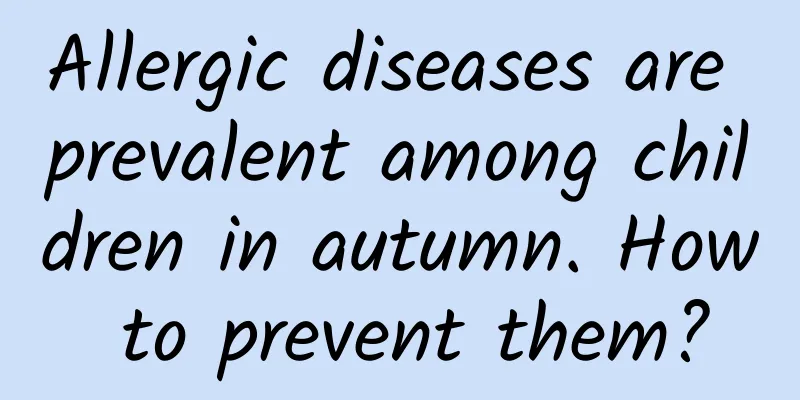Allergic diseases are prevalent among children in autumn. How to prevent them?

|
Autumn is the peak season for allergic diseases in children. Due to changes in environmental factors such as temperature, humidity, and wind direction, many annual herbaceous plants bloom, pollinate, and spread with the help of wind in autumn. When these pollens meet children with allergies, they will experience a series of uncomfortable symptoms such as runny nose and sneezing, itchy nose and eyes, coughing and wheezing, shortness of breath, chest tightness, and itchy skin. So, what are the common allergens in autumn? Pollen: Autumn is the season when many weeds bloom. The pollen particles of these weeds are small and dry, and they tend to float in the air, which is one of the main causes of autumn allergies. In particular, pollen from plants such as Artemisia, Chenopodiaceae/Amaranthaceae, and Humulus are highly allergenic. Dust mites: The air is dry in autumn, and lack of ventilation in the indoor environment can easily lead to the breeding of dust mites. Dust mites and their excrement are common indoor allergens that can cause skin and respiratory allergies. Image source: Pixabay Mold: Morning dew or rainfall residue, fallen leaves and decaying vegetation in autumn can help mold grow. Mold spores are airborne and can cause allergies if touched or inhaled. Animal fur: The temperature in autumn is suitable and pets become more active. Their fur, saliva, urine, etc. may also become allergens. Food: Certain foods such as milk, eggs, peanuts, seafood, etc. are also common allergens. Changes in children's diet in autumn may increase the risk of allergies. What are the common allergic diseases in autumn? Allergic rhinitis: Allergic rhinitis in autumn is often manifested by symptoms such as sneezing, runny nose, itchy nose, and nasal congestion. Some children may also experience decreased sense of smell. Image source: Pixabay Allergic conjunctivitis: Itchy eyes, tearing, red eyes and burning sensation are common symptoms of allergic conjunctivitis, which often occur at the same time as allergic rhinitis. Allergic asthma: Autumn is one of the peak seasons for asthma. Children often experience symptoms such as wheezing, coughing, and chest tightness due to sudden contact with allergens or irritation. Urticaria: Autumn urticaria is mostly caused by food, cold air, contact with mites, etc. It manifests as itching all over the body, followed by the appearance of bright red or light red wheals. Atopic dermatitis: The air is dry in autumn and the skin barrier function is weakened, which can easily cause atopic dermatitis, manifested by symptoms such as dry skin, itching, erythema, and papules. How to prevent and treat allergic diseases in autumn? Avoid contact with allergens: Understand what substances your child is allergic to and try to avoid contact. For example, keep the room clean and ventilated, clean the air conditioning filter regularly; use anti-mite sheets, pillowcases and bedding; avoid going out when the pollen concentration is high or take protective measures (such as wearing a mask). Improve physical fitness: Encourage children to participate in outdoor sports to improve their physical fitness. Add clothes in time according to climate changes to avoid catching cold. Diet adjustment: Pay attention to a balanced diet and eat more foods rich in antioxidants such as vitamins C and E. For children with a history of food allergies, special attention should be paid to avoiding allergic foods. Drug treatment: Use anti-allergic drugs (such as antihistamines) for treatment under the guidance of a doctor. For children with severe allergic symptoms or recurrent attacks, desensitization treatment may be considered. Health education: Strengthen health education for parents and children, improve children's understanding and prevention awareness of allergic diseases, and educate children to develop good hygiene habits and lifestyles. Source: Chongqing Banan District Second People's Hospital Audit experts: Zhang Ling, Jin Gang Statement: Except for original content and special notes, some pictures are from the Internet. They are not for commercial purposes and are only used as popular science materials. The copyright belongs to the original authors. If there is any infringement, please contact us to delete them. |
Recommend
Ectopic pregnancy bleeding color and picture
Pregnant mothers are particularly worried about t...
Can calcium supplementation be used to treat calcium deficiency? The calcium tablets you swallow may not have entered your bones!
Author: Qu Tiebing, Chief Physician, Beijing Boai...
What is the difference between selenium-enriched eggs and ordinary eggs? Should eggs be stored in the refrigerator?
Eggs are the best choice for people who need to s...
How long does it take to cure endometritis?
Endometritis is a health problem that many people...
What are we looking at when we look at a face?
Is it superficial to judge by appearance? There i...
How many times a week do women have sex?
How many times a week a woman has sex depends on ...
What happens if the nipple is inverted? Experts answer your questions
Under normal circumstances, women's nipples a...
What is the cause of bleeding after virgin sex?
Virgin is now widely used to refer to a fresh fee...
How to tie a belly band for caesarean section
Now that medical equipment is becoming more and m...
What you need to know about fasting test
"This examination requires you to fast. You ...
Is sweating after induction of labor good or bad?
Every woman wants to give birth to a healthy baby...
Why do I have a headache when my period comes?
For women, one of the most troublesome things is ...
How many days can I detect pregnancy?
Many women are inevitably excited when they are p...









